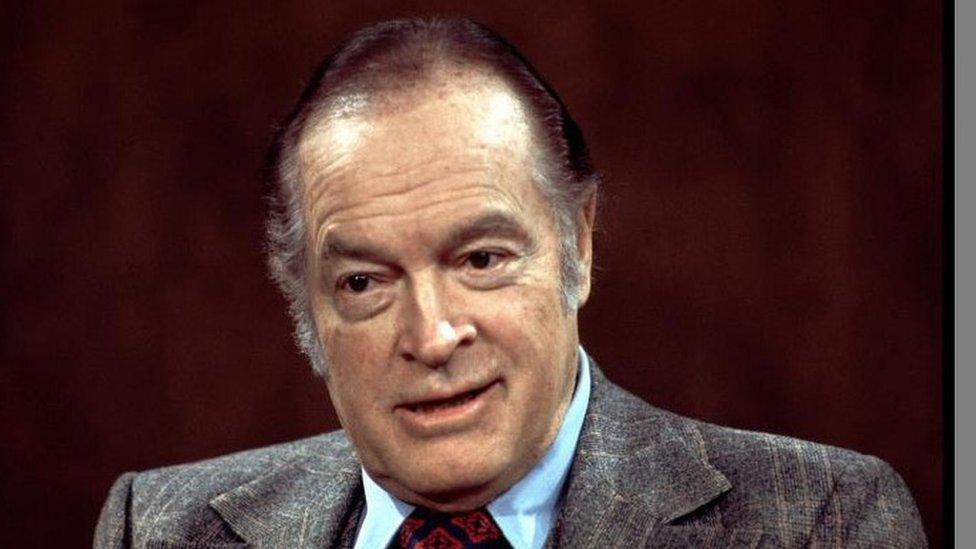Bob Hope Age, Date Of Birth, Bio, Family And Net Worth
Bob Hope: Age, Date of Birth & other info
Bob Hope, born Leslie Townes Hope on May 29, 1903, in Eltham, London, England, was a versatile entertainer whose career spanned nearly eight decades. Renowned for his wit, comedic timing, and dedication to entertaining the masses, Hope’s contributions to the entertainment industry and his service to American troops during wartime earned him a special place in the annals of show business history.
- Age: 100 Years on July 27, 2003
- Date of Birth: May 29, 1903
- Birth Place: Eltham, London, England
- Weight: 160-170 pounds
- Height: 5’10” (178 cm)
- Net Worth: $150–200 million

Early Life and Family Background
Bob Hope was born into a modest household as the fifth of seven sons to William Henry Hope and Avis Townes Hope. His father, a stonemason, hailed from Weston-super-Mare, Somerset, while his mother, a light opera singer, was Welsh. The Hope family emigrated to the United States in 1908 when Bob was just four years old, settling in Cleveland, Ohio. The move marked the beginning of a new chapter for young Leslie, whose talents for entertaining emerged early.Growing up in a working-class neighborhood, Hope contributed to the family income by performing on the streets of Cleveland. He sang, danced, and impersonated famous figures of the era, displaying an early knack for comedy. His big break as a performer came when he won a Charlie Chaplin impersonation contest in 1915, signaling his future in entertainment.
Education and Early Career
Hope attended East High School in Cleveland, but his restless energy led him to explore different avenues of work. For a brief period, he pursued boxing under the name “Packy East”, achieving moderate success. However, the allure of the entertainment industry was too strong to resist.In the early 1920s, Hope entered the world of vaudeville, partnering with George Byrne and later forming acts with others, including the Hilton Sisters, famous conjoined twins. By 1929, he adopted the name “Bob”, a more approachable and memorable stage persona. This marked the beginning of his rise to fame.
Rise to Stardom
Bob Hope’s career took off in the late 1920s and 1930s with performances in vaudeville and Broadway productions. Notable stage appearances included roles in “Roberta,” “Say When,” and “Ziegfeld Follies.” These performances showcased his comedic talent and opened the door to radio.In 1938, Hope became a household name with his radio program “The Pepsodent Show.” His rapid-fire delivery of jokes, often laced with self-deprecating humor, resonated with listeners. Around this time, Hope ventured into film, starring in “The Big Broadcast of 1938,” where he performed his signature song, “Thanks for the Memory.” This song became synonymous with Hope’s career and was often used as a closing theme in his performances.
Film Career and the “Road to…” Series
Hope’s film career flourished during the 1940s and 1950s, with roles in over 70 films, including 54 feature films. Among his most iconic contributions to cinema was the “Road to…” series, a collection of seven musical comedies co-starring Bing Crosby and Dorothy Lamour. These films, including titles like “Road to Morocco” and “Road to Bali,” were celebrated for their humor, improvisation, and camaraderie between the leads.
Television and Later Career
With the advent of television in the 1950s, Hope transitioned seamlessly into the new medium. He hosted numerous television specials on NBC, including variety shows, comedy hours, and holiday-themed programs. Hope also became synonymous with the Academy Awards, hosting the Oscars 19 times, more than any other individual. His appearances were known for his playful jabs at Hollywood celebrities and his ability to engage live and television audiences alike.
Dedication to the Troops: USO Tours
Perhaps the most enduring aspect of Bob Hope’s legacy was his unwavering dedication to entertaining American troops. From World War II through the Gulf War, Hope performed in 57 United Service Organizations (USO) tours, often in dangerous and remote locations.
- World War II: Hope traveled to Europe, Africa, and the Pacific to bring laughter and music to soldiers stationed far from home.
- Vietnam War: His performances during the Vietnam War were particularly significant, offering moments of levity amidst the turmoil of the conflict.
- Recognition: In 1997, Congress honored Hope by declaring him an “Honorary Veteran of the Armed Forces,” a unique accolade for a civilian.
Personal Life
Bob Hope married Dolores DeFina, a singer, in 1934. The couple adopted four children: Linda, Tony, Kelly, and Nora. Hope’s public image as a devoted family man, however, was occasionally overshadowed by rumors of extramarital affairs, which were detailed in biographies published after his death. Despite these controversies, Dolores and Bob remained married until his passing in 2003.
Net Worth and Real Estate
Bob Hope amassed significant wealth during his lifetime, with his net worth estimated between $115 million and $150 million at the time of his death.
- Real Estate Holdings: Hope owned an impressive portfolio of real estate, including properties in Southern California and a sprawling estate in Palm Springs. During his lifetime, some estimates of his fortune reached as high as $700 million, largely due to the value of his properties.
- Humor About Wealth: When asked about his net worth, Hope often quipped that the numbers were exaggerated, showcasing his trademark humor.
Later Years and Death
Hope officially retired from public life in 1999, though he continued to make occasional appearances. He celebrated his 100th birthday on May 29, 2003, receiving tributes from world leaders, Hollywood luminaries, and fans. Just two months later, on July 27, 2003, Bob Hope passed away at his home in Toluca Lake, California, due to pneumonia.
Legacy and Honors
Bob Hope’s legacy is unparalleled in the entertainment world. His contributions include:
- Presidential Medal of Freedom (1969): Awarded for his service to the arts and the nation.
- Kennedy Center Honors (1985): Recognized for lifetime achievements in the performing arts.
- Congressional Gold Medal (1962): Awarded for his contributions to morale during wartime.
Hope’s dedication to philanthropy and the military, combined with his influence on comedy and entertainment, ensures his place as a cultural icon.
Conclusion
Bob Hope was more than just an entertainer; he was a symbol of resilience, humor, and patriotism. From his humble beginnings in England to his rise as one of the most celebrated performers in the world, Hope’s journey exemplifies the power of talent, hard work, and an unwavering commitment to bringing joy to others.




